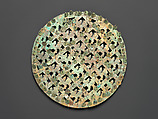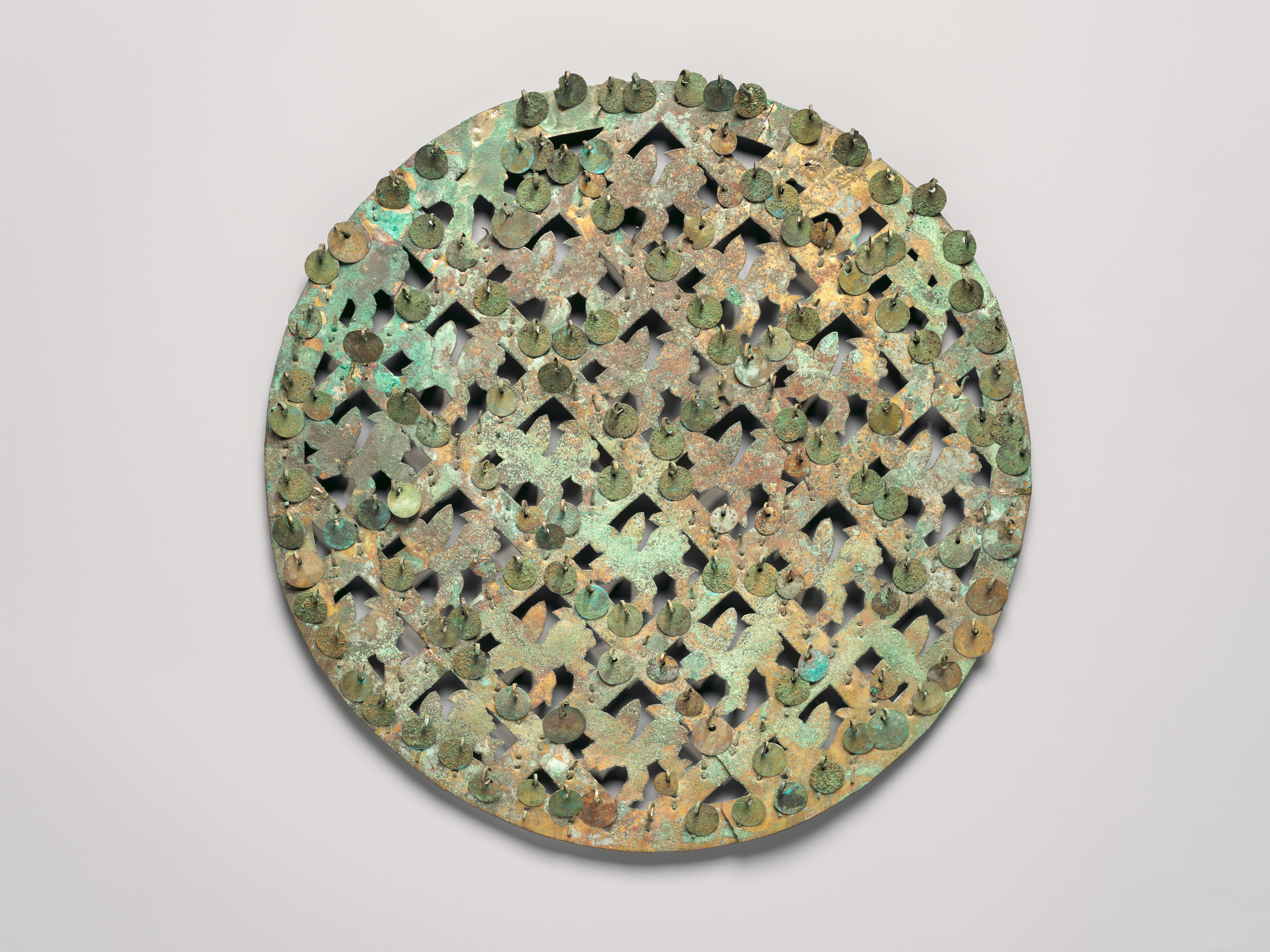Disk Ornament
Not on view
This gilded copper disk, produced by artisans of the Moche culture in northern Peru, is a testament to the impressive skills of metal workers in the Andean region in the Early Intermediate period (200 B.C.–A.D. 600). The disk, perhaps a decorative addition to a small, hand-held shield, was originally cut from a larger sheet of hammered copper and subsequently gilded. The lattice design includes silhouettes of deer in the interstices, their legs flexed, giving the impression of animals in flight, driven into the net-like lattice. Deer hunting scenes illustrated on Moche ceramics show hunters capturing their prey by driving them into nets (Donnan, 1997; Donnan and McClelland, 1999; Lavalle, 1970). Here both the net and the circumference of the disk are adorned with gilded dangles suspended by copper wires fixed to the back of the disk. This would have yielded a strikingly animated image when illuminated by the sun or torchlight.
The wires that hold the dangles are oriented so that only when the disk is in the proper position do the ornaments hang within the circumference of the gilded copper disk. (In any other orientation, some dangles would hang beyond the edges of the disk.) The use of disks such as the present example is unclear. They may have served as shield frontals, attached to a cane backing now lost. The delicate nature of the metal ornament would have provided little physical protection in battle, but the imagery itself may have been thought to have certain apotropaic qualities. Alternatively, these disks may have been attached to textile banners or some other type of object.
The Moche (also known as the Mochicas) flourished on Peru’s North Coast from A.D. 200–850, centuries before the rise of the Incas. Over the course of some six centuries, the Moche built thriving regional centers from the Nepeña River Valley in the south to perhaps as far north as the Piura River, near the modern border with Ecuador, developing coastal deserts into rich farmlands and drawing upon the abundant maritime resources of the Pacific Ocean’s Humboldt Current. Although there is debate as to whether the Moche ever formed a single centralized political entity, the regional centers shared unifying cultural traits such as religious practices (Donnan, 2010).
This object was said to have been found at the burial site of Loma Negra, which was one of the most northern outposts of Moche culture. Loma Negra works in metal share similar iconography with ceramics and metalwork found at Moche sites father to the south, such as Ucupe (Bourget, 2014). The precise relationship between the Loma Negra and the Moche “heartland” remains a subject of debate, however (Kaulicke, 2006).
References and Further Reading
Bourget, Steve. Les rois mochica: Divinité et pouvoir dans le Pérou ancien. Paris: Somogy éditions d'art; Geneva: MEG, Musée d'ethnographie de Genève, 2014.
Castillo, Luis Jaime. “Masters of the Universe: Moche Artists and Their Patrons.” In Golden Kingdoms: Luxury Arts in the Ancient Americas, edited by Joanne Pillsbury, Timothy Potts, and Kim N. Richter. Los Angeles: J. Paul Getty Museum, 2017, pp. 24-31.
Donnan, Christopher B., 1997. “Deer Hunting and Combat: Parallel Activities in the Moche World.” In The Spirit of Ancient Peru: Treasures from the Museo Arqueológico Rafael Larco Herrera, edited by Kathleen Berrin, pp. 50-59. San Francisco: Fine Arts Museums of San Francisco in association with Thames & Hudson.
Donnan, Christopher B. “Moche State Religion.” In New Perspectives on Moche Political Organization, edited by Jeffrey Quilter and Luis Jaime Castillo. Washington D.C.: Dumbarton Oaks Research Library and Collection, 2010, pp. 47-69.
Donnan, Christopher B. and Donna McClelland, Moche Fineline Painting: Its Evolution and Its Artists. Los Angeles: Fowler Museum of Cultural History, University of California, 1999.
Kaulicke, Peter. “The Vicús-Mochica Relationship.” In Andean Archaeology III, edited by William H. Isbell and Helene H. Silverman. Boston, MA: Springer, 2006, pp. 85-111.
Lavallée, Danièle. Les représentations animales dans la ceramique Mochica. Mémoires de l’Institute d’Ethnologie. Paris: Musée de l’Homme, 1970.
Lechtman, Heather, Antonieta Erling, and Edward J. Barry, Jr. "New Perspectives on Moche Metallurgy; Techniques of Gilding Copper at Loma Negra, Northern Peru." American Antiquity vol. 47 (1982), pp. 3-30.
Schorsch, Deborah, Ellen G. Howe, and Mark T. Wypyski, “Silvered and Gilded Copper Metalwork from Loma Negra: Manufacture and Aesthetics.” Boletín Museo del Oro vol. 4 (1996), pp. 145-163.
Schorsch, Deborah. "Silver-and-Gold Moche Artifacts from Loma Negra, Peru." Metropolitan Museum Journal vol. 33 (1998).
Due to rights restrictions, this image cannot be enlarged, viewed at full screen, or downloaded.
This artwork is meant to be viewed from right to left. Scroll left to view more.



